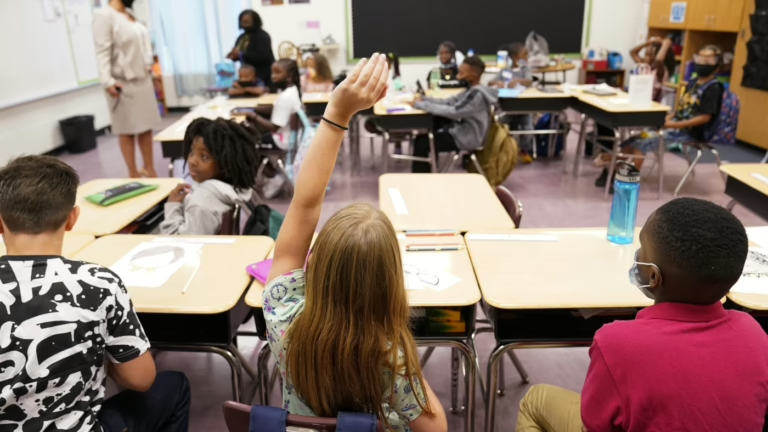A student raises their hand in a classroom at Tussahaw Elementary School in 2021 in McDonough, Ga.
Brynn Anderson/AP Photo
hide caption
toggle caption
Brynn Anderson/AP Photo
Recent assessment results reveal that students from third to eighth grade continue to grapple with the lingering academic setbacks caused by the pandemic, particularly in reading. While math scores show a slight upward trend or stability, all grade levels still trail behind the performance benchmarks established in 2019.
This information is derived from the Spring 2025 MAP Growth assessments conducted by NWEA, a prominent organization specializing in K-12 educational testing and research, which evaluates millions of students across thousands of schools nationwide.

“Math achievement is making gradual progress, albeit slowly, but reading scores remain stagnant,” explains Karyn Lewis, NWEA’s vice president of research. “It’s tempting to hope this chapter is behind us, but the data clearly indicate otherwise. Ignoring these results won’t resolve the issue; it would mean accepting these setbacks as permanent, which is unacceptable.”
In addition to the assessment results, NWEA has introduced a new publicly accessible performance dashboard designed to assist educators and policymakers in comparing their students’ progress against a comprehensive national sample.
Reading Proficiency Remains Flat
The spring 2025 reading results offer little cause for optimism. Gains observed in 2022 across various grade levels have largely vanished, with many students performing at or below the lowest levels recorded during the pandemic.
Overall, third- through eighth-graders continue to lag behind their 2019 counterparts. This stagnation is evident across all racial, ethnic, and economic groups, according to NWEA’s official statement.
Math Scores Show Modest Recovery
Math performance presents a slightly more encouraging picture. Several grade levels have demonstrated incremental improvements compared to 2024, and a slow but steady upward trend has been visible since 2021.
Importantly, these math gains are consistent across diverse student populations, irrespective of race, ethnicity, or socioeconomic background.
Despite this progress, no grade has yet returned to the pre-pandemic achievement levels seen in 2019.

The findings from NWEA align with concerning trends reported earlier this year by federal data from the Nation’s Report Card, underscoring the ongoing challenges in student achievement.
Introducing a New Performance Dashboard
To provide more timely insights, NWEA has launched a new interactive dashboard that allows school districts and policymakers to monitor their students’ academic standing relative to national averages.
This tool will be refreshed triannually, offering more frequent updates than the biennial releases of the Nation’s Report Card.
Tom Kane, from Harvard’s Center for Education Policy Research, compares this frequent data release to regular health checkups, emphasizing its importance for tracking recovery after a significant setback like the pandemic. “Waiting two years between assessments is too long for students recovering from such disruptions,” Kane notes, calling the dashboard a vital supplement to existing federal data.
Megan Kuhfeld, NWEA’s director of growth modeling and data analytics, highlights the uneven nature of recovery within schools and classrooms. She stresses that national trends serve as a crucial starting point for local educators to investigate deeper and identify where targeted support and resources are most needed.

This initiative to equip districts and states with more frequent and detailed data comes amid significant reductions to the Institute of Education Sciences (IES) under the previous administration. The IES, a branch of the U.S. Department of Education, traditionally plays a key role in gathering and disseminating federal student achievement statistics.






















